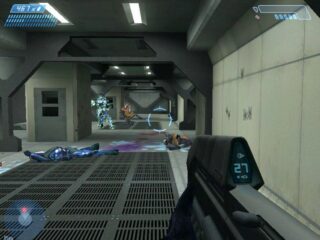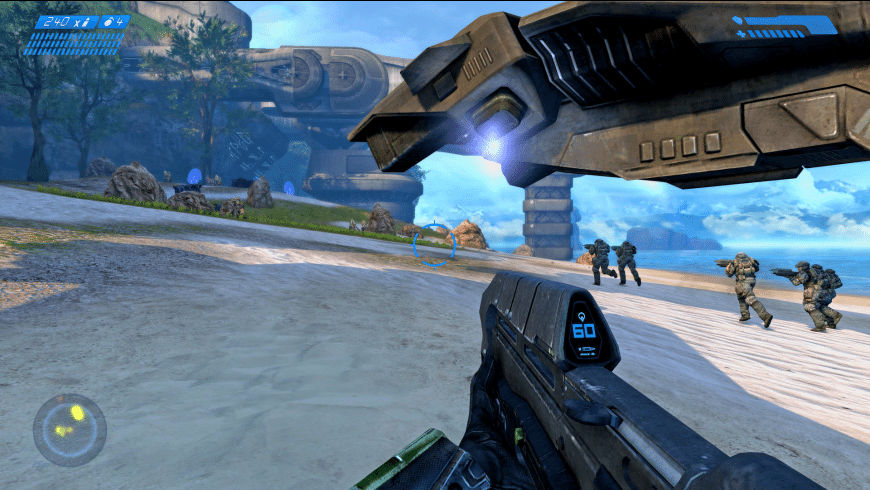More than a year and a half following the game's initial release on the Macintosh, MacSoft has finally released a demo version of Halo, the first person action game developed by Bungie Studios. The 122MB demo download is available from Macgamefiles.com.
Halo originally debuted as a first person shooter for Macs and PCs developed by then-independent game developer Bungie Software, creators of the legendary Myth and Marathon game series. Shortly after publicly introducing the title, Bungie Studios was acquired by Microsoft Corp. as a first-party developer of software for Microsoft's then-fledgling Xbox video game console.
Light Halo Mac Os Catalina
Long after Halo first debuted as an Xbox-exclusive game title, Gearbox Software set to work on a PC game conversion, and Macsoft licensed the Macintosh rights to the game, releasing it only a couple of months after the PC version was released in late 2003. Bungie Studios has since released Halo 2, thus far an Xbox-exclusive.
How to get Halo on mac completely free http://tinyurl.com/94ohsh6. In Halo Wars, the MAC Blast ability allows the player to use UNSC Spirit of Fire 's MAC for pinpoint orbital bombardment. It is mainly used as a support weapon to help the UNSC penetrate heavy Covenant defenses and Covenant bases, and is a potent weapon against Scarabs.
Microsoft chairman Bill Gates told Time magazine earlier this year that Bungie is working on Halo 3 for the company's next-generation Xbox 360 video game console, which will make its debut later this year. Gates said that Halo 3 is expected to be released for Xbox 360 sometime in 2006, roughly at the same time as Sony is expected to release its PlayStation 3 video game console. Neither Microsoft nor Bungie has confirmed that news, however.
Halo: Combat Evolved, simply known as Halo, is a first-person shooter game developed by Bungie and published by Microsoft Game Studios.It was released as a launch game for Microsoft's Xbox video game console on November 15, 2001. Microsoft released versions of the game for Windows and Mac OS X in 2003. The game was later released as a downloadable Xbox Original for the Xbox 360.
The demo version gives players a taste of both single and multiplayer gameplay, with some limited vehicle combat. The single player campaign level included is called 'The Silent Cartographer,' while the multiplayer map is called 'Blood Gulch' and supports up to 16 human opponents. The demo version is Mac to Mac only and you can't save your progress.
System requirements call for a G4/1GHz or faster, Mac OS X v10.2.8 or later, 256MB RAM, and a 3D graphics card with 32MB VRAM or more.
| Minotaur: The Labyrinths of Crete | |
|---|---|
| Developer(s) | Bungie |
| Publisher(s) | Bungie |
| Designer(s) | Jason Jones |
| Platform(s) | Mac OS |
| Release | 1992 |
| Genre(s) | Role-playing, adventure |
| Mode(s) | Single-player, multiplayer |
Minotaur: The Labyrinths of Crete is a 1992 role-playingadventure video game for Macintosh by Bungie; produced by Jason Jones and Alex Seropian. The game distinguished itself from other games of its time by including a multiplayer mode that functioned over the AppleTalk protocol or Point-to-Point Protocol. A single-player exploration mode was also available, but this mode had no end goal and was useful to discover how the various items found in the maze operated. The game originated in 1988 as an Apple game played over a modem between two opponents, but was never officially released on that platform.
The game's tagline was 'Kill your enemies. Kill your friends' enemies. Kill your friends'. This tagline has reappeared as a description in the multiplayer menu screens for some of Bungie's other games, such as Myth: The Fallen Lords and Halo 3.

Bungie later licensed Minotaur's game engine to the studio Paranoid Productions (Richard Rouse) who used it to create Odyssey: The Legend of Nemesis, released in 1996.
Light Halo Mac Os X
Reception[edit]
Computer Gaming World favorably reviewed Minotaur although criticizing its not using the mouse and lack of a single-player option, and concluded that 'a group of dedicated opponents [that] enjoy fast-thinking and ad-lib strategizing will find long-lasting enjoyment from this game'.[1] The game was reviewed in 1992 in Dragon #188 by Hartley, Patricia, and Kirk Lesser in 'The Role of Computers' column. The reviewers gave the game 4 out of 5 stars.[2]
See also[edit]

Bungie later licensed Minotaur's game engine to the studio Paranoid Productions (Richard Rouse) who used it to create Odyssey: The Legend of Nemesis, released in 1996.
Light Halo Mac Os X
Reception[edit]
Computer Gaming World favorably reviewed Minotaur although criticizing its not using the mouse and lack of a single-player option, and concluded that 'a group of dedicated opponents [that] enjoy fast-thinking and ad-lib strategizing will find long-lasting enjoyment from this game'.[1] The game was reviewed in 1992 in Dragon #188 by Hartley, Patricia, and Kirk Lesser in 'The Role of Computers' column. The reviewers gave the game 4 out of 5 stars.[2]
See also[edit]
- Pathways into Darkness, originally to be a sequel to this game[3]
References[edit]
Light Halo Mac Os Update
- ^Fisher, William C. (October 1992). 'A Designer Looks at Minotaur'. Computer Gaming World. p. 96. Retrieved 4 July 2014.CS1 maint: discouraged parameter (link)
- ^Lesser, Hartley; Lesser, Patricia & Lesser, Kirk (December 1992). 'The Role of Computers'. Dragon (188): 57–64.
- ^Rouse III, Richard (October 1993). 'IMG Interview: Bungie's Jason Jones'. Inside Mac Games.
External links[edit]
- Minotaur: The Labyrinths of Crete at MobyGames
